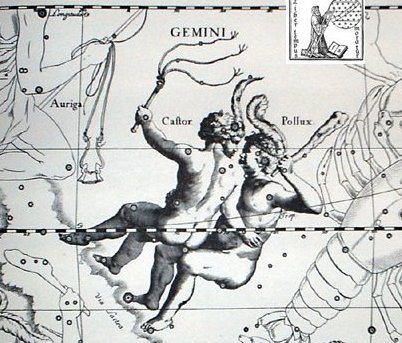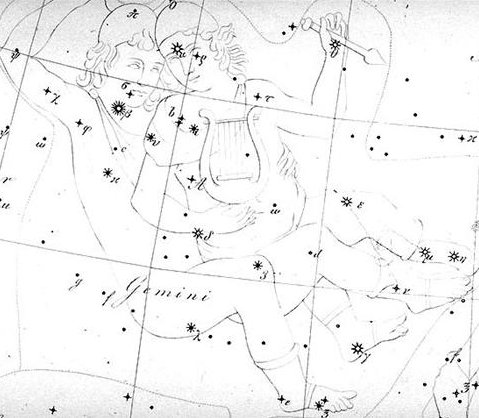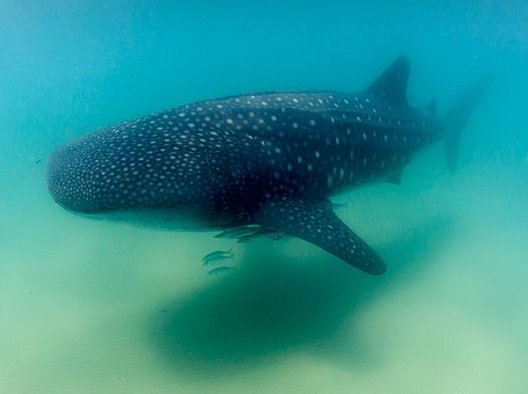In other words, there
should be 100 days beyond Deneb Algiedi to the end of the
year:
|
no glyph |
 |
 |
182 |
 |
79 |
 |
|
Ga1-1 |
Ga1-2 |
Ga7-16 (185) |
Gb2-10
(265) |
|
Hyadum II
(δ¹ Tauri)
(64.2) |
AIN,
θ¹ Tauri, θ² Tauri
(65.7) |
no star listed (66) |
ANTARES
(249.1), Marfik, φ Ophiuchi (249.5), ω Ophiuchi
(249.8) |
Enif, Erakis (329.2), 46 Capricorni, Jih
(329.3), ι Piscis Austrini (329.4), λ
Capricorni (329.6), ν Cephei (329.7),
DENEB ALGIEDI (329.8) |
|
0h |
1 |
2 |
185 |
265 |
|
spring equinox |
March 22 (81) |
23 |
September 22 (265) |
December 11 (345) |
|
97 |
 |
 |
 |
 |
|
Gb5-10 |
Gb5-11 |
Gb5-12 (365) |
Gb5-13 |
|
Hyadum I
(63.4) |
Hyadum II
(δ¹
Tauri) (64.2) |
AIN,
θ¹ Tauri, θ² Tauri
(65.7) |
no star listed (66) |
|
363 |
364 |
365 |
366 |
|
March 20 |
spring equinox |
22 (81) |
23 |
The apex drawn inside the great head
of the 'whale shark' in Gb2-10 ought to be related
in some way
to the sign in the mago type of glyph in
Ga2-14, and indeed it is:
 |
 |
 |
 |
|
Ga2-9 |
Ga2-10 |
Ga2-11 (31) |
Ga2-12 |
|
θ Gemini (103.0), ψ8
Aurigae (103.2),
Alhena
(103.8), ψ9 Aurigae
(103.9) |
Adara (104.8) |
ω Gemini (105.4),
Alzirr
(105.7), Muliphein
(105.8), Mekbuda (105.9) |
7h (106.5) |
|
no star listed (106) |
|
29 |
30 |
31 |
32 |
|
April
19 |
20 |
21 (111) |
22 |
 |
 |
... Later
on in this series of rituals, the Chorti go through a
ceremony they call raising the sky. This ritual takes
place at midnight on
the twenty-fifth of April
and continues each night until the rains arrive ... |
 |
 |
 |
223 |
|
Ga2-13 |
Ga2-14 |
Ga2-15 |
Ga2-16 |
Ga2-17 |
|
Wezen (107.1), τ Gemini
(107.7), δ Monocerotis
(107.9) |
no star listed (108 = 6
* 18) |
λ Gemini (109.4),
WASAT
(109.8) |
no star listed (110) |
Aludra (111.1), Propus
(111.4), Gomeisa
(111.6) |
|
33 |
34 |
35 |
36 |
37 |
|
April 23 |
24 (114 = 6 * 19) |
April
25 |
26 |
27 |
 |
 |
 |
 |
 |
 |
|
Gb2-6 |
Gb2-7 |
Gb2-8 |
Gb2-9 |
Gb2-10
(265) |
Gb2-11 |
|
Al Sa'd al Su'ud-22 /
Emptiness-11
BUNDA
(Foundation) / KAKKAB
NAMMAΧ (Star of Mighty Destiny) |
no star
listed (326) |
Castra (327.2),
BUNDA
(327.5)
Sirius |
Nashira (328.0),
Azelfafage, κ Capricorni (328.7) |
Enif, Erakis (329.2), 46 Capricorni, Jih
(329.3), ι Piscis Austrini (329.4), λ
Capricorni (329.6), ν Cephei (329.7),
DENEB ALGIEDI (329.8) |
θ Piscis
Austrini (330.1) |
|
Tsin
(325.2), Alphirk (325.7),
SADALSUD,
ξ Gruis (325.9) |
|
February
9 |
10 |
11 |
12 |
13 |
14 (45) |
|
Tehetu'upú 9 |
10 |
11 |
12 (408) |
13
(*329) |
14 |
|
ºFebruary 5 (36) |
6 |
7 (403) |
8 |
9 (*325) |
10 |
|
'January 13 (378) |
14 |
15 |
16 (*301) |
17 |
18 (383) |
|
"
Dec 30 (364) |
31
(*285) |
"January
1 (366) |
2 |
3 (368) |
4 |
|
Star-25
ANA-HEU-HEU-PO |
Al Tarf-7 |
A Hydrae
(144.1)
Vega
|
Ukdah (145.4), κ Hydrae
(145.5), Subra (145.8) |
ψ Leonis (146.4), Ras
Elaset Australis (146.6) |
Vathorz Prior (147.9) |
|
ALPHARD
(142.3), ω Leonis (142.6), τ¹ Hydrae
(142.7) |
ψ Velorum
(143.3),
ALTERF,
τ² Hydrae (143.4), ξ Leonis (143.5) |
|
August
10 |
11 |
12 |
13 |
14 |
15 |
|
Hora Iti
10 |
11 |
12
(*144) |
13 |
14 |
15 (227) |
|
ºAugust
6 |
7 |
8 (220) |
9 |
10 |
11 |
|
'July 14
(*115) |
15 |
16 |
17 |
18 |
19 (200) |
|
"June 30
(*101) |
"July 1 |
2 (183) |
3
(*204) |
4 |
5 |
My interpretation of the text is
therefore probably correct.
The inside and upwardly stretching
straight line in Ga2-14 should refer to the path
ahead, with 'land drawn up' at heliacal Gemini (cfr
Ga2-11 at the day before 7h). From there to the left
shoulder of Aquarius there were 261 (Sadalsud) - 34
(Ga2-14) = 227 days (alluding to 22 /7). And 4 days
after heliacal Sadalsud the path began to descend,
where the left half of the tail of the Capricorn
crossed over the left arm of Aquarius.

The distance from Mayan 'February 9'
to 'April 25' can be counted as 115 (April 25) -
40 (February 9) = 75 days, although the facts above
appear to point
in some other direction:
February 9 (heliacal Sadalsud) =
325.9 in rongorongo times. Heliacal Wasat (the
Middle, δ Gemini)
was at Ga2-15 in rongorongo times. Hevelius appears
to have placed Wasat at the navel, te pito,
the midpoint
of Pollux, but the position could also be at the
right wrist of Castor:
 
325.9 (Sadalsud) - 109.8 (Wasat) = 216.1 (or approximately
3 * 73 days).
|
Pito
1. Umbilical cord; navel;
centre of something: te pito o te henua,
centre of the world. Ana poreko te poki,
ina ekó rivariva mo uru ki roto ki te hare o
here'u i te poki; e-nanagi te pito o te
poki, ai ka-rivariva mo uru ki roto ki te
hare, when a child is born one must not
enter the house immediately, for fear of
injuring the child (that is, by breaking the
taboo on a house where birth takes place);
only after the umbilical cord has been
severed can one enter the house. 2. Also
something used for doing one's buttons up
(buttonhole?). Vanaga.
Navel. Churchill.
H Piko 1. Navel,
navel string, umbilical cord. Fig. blood
relative, genitals. Cfr piko pau 'iole,
wai'olu. Mō ka piko, moku ka piko,
wehe i ka piko, the navel cord is cut
[friendship between related persons is
broken; a relative is cast out of a family].
Pehea kō piko? How is your navel [a
facetious greeting avoided by some because
of the double meaning]? 2. Summit or top of
a hill or mountain; crest; crown of the
head; crown of the hat made on a frame (pāpale
pahu); tip of the ear; end of a rope;
border of a land; center, as of a fishpond
wall or kōnane board; place where a
stem is attached to the leaf, as of taro. 3.
Short for alopiko. I ka piko nō
'oe, lihaliha (song), at the belly
portion itself, so very choice and fat. 4. A
common taro with many varieties, all with
the leaf blade indented at the base up to
the piko, junction of blade and stem.
5. Design in plaiting the hat called
pāpale 'ie. 6. Bottom round of a
carrying net, kōkō. 7. Small wauke
rootlets from an old plant. 8. Thatch above
a door. 'Oki i ka piko, to cut this
thatch; fig. to dedicate a house. Wehewehe. |

Wasat at the right wrist of Pollux
can be compared to the position of ν Aquarii at the
left wrist of Aquarius. 256 (ν Aquarii) - 35 (Wasat)
= 220:
 |
 |
 |
 |
 |
 |
|
Gb1-23 |
Gb1-24 |
Gb1-25 |
Gb1-26 |
Gb2-1 (256) |
Gb2-2 |
|
μ Aquarii
(316.0) |
ε Equulei (317.8) |
no star listed (318) |
21h (319.6) |
χ Capricorni (320.0),
ν Aquarii
(320.3), γ Equulei (320.6), ο
Pavonis (320.8) |
δ
Equulei (321.7), φ Capricorni
(321.8) |
|
Armus (319.0), Dorsum (319.3),
Tsoo (319.7) |
|
January 31 |
February 1 |
2 |
3 |
4 (400) |
5 (36) |
|
Tua Haro 31 |
Tehetu'upú 1 |
2 |
3 |
4 (400) |
5 (36) |
|
ºJan 27 (392) |
28 |
29 (*314) |
30 |
31 (396) |
ºFebruary 1 |
|
'January 4 |
5 (370) |
6 (*291) |
7 |
8 |
9 |
|
'Tua
Haro 4 |
5 |
6 |
7 |
8 |
9 |
|
SOLSTICE |
"December 22 |
23 |
CHRISTMAS EVE |
25 (359) |
26 (*280) |
|
no
star listed (133) |
ζ
Hydrae (134.1), ρ Cancri (134.2), ο
Cancri (134.6) |
Acubens, Talitha Borealis (135.0), σ
Cancri (135.2), ρ Ursa Majoris
(135.6) |
ν
Cancri (136.0),Talitha Australis
(136.1), ωHydrae (136.8) |
9h (137.0) |
no star listed (138) |
|
σ¹ Ursa
Majoris (137.0), κ Cancri (137.3), τ
Cancri (137.4), Alsuhail (137.5),
σ² Ursa Majoris (137.6), τ Ursa
Majoris (137.7),
ξ Cancri
(137.8) |
|
August 1 |
2 |
3 |
4 (216) |
5 |
6 |
|
Hora Iti 1 |
2 |
3 |
4 (216) |
5 |
6 |
|
ºJuly 28 |
29 (*130) |
30 |
31 |
ºAugust 1 (213) |
2 |
|
'July 5 |
6 (*107) |
7 |
8 |
9 |
10 |
|
'He Anakena 5 |
6 |
7 |
8 |
9 (190) |
10 |
|
SOLSTICE |
"June 22 (*93) |
23 |
ST JOHN'S EVE |
25 |
26 (177) |
|
Egyptian cobra in repose |
 |
Phoenician nūn |
 |
Greek
nu |
Ν (ν) |
|
... Nun
is thought to have come from
a pictogram of a snake (the
Hebrew word for snake,
nachash begins with a
Nun and snake in Aramaic
is nun) or eel.
Some have
hypothesized a hieroglyph of
a fish in water for its
origin (in Arabic,
nūn means large
fish or whale). The
Phoenician letter was named
nūn 'fish', but the
glyph has been suggested to
descend from a hypothetical
Proto-Canaanite
nah 'snake',
based on the name in
Ethiopic, ultimately from a
hieroglyph representing a
snake.
... Nah in
modern Arabic literally
means 'bad luck'. The
cognate letter in Ge'ez and
descended Semitic languages
of Ethiopia is nehas,
which also means 'brass'. |
The proper animal for
representing ν Aquarii should be a
whale-shark, I think, i.e. a creature
born half
from land and half from the sea. Once
whales walked on land, and they
still need air.

256 (ν Aquarii) and
265 (Deneb Algiedi):
 |
 |
224 |
 |
 |
 |
 |
 |
|
Ga1-30 |
Ga2-1 |
Gb2-1
(256) |
Gb2-2 |
Gb2-3 |
Gb2-4 |
Gb2-5 |
|
Furud
(94.9) |
Well-22 |
χ
Capricorni (320.0),
ν
Aquarii
(320.3), γ Equulei (320.6), ο Pavonis (320.8) |
δ Equulei (321.7), φ
Capricorni (321.8) |
Kitalpha
(322.0), Alderamin (322.9) |
Dai
(323.5), β Equulei (323.8) |
γ Pavonis
(324.1), Yan (324.6) |
|
δ
Columbae (95.2),
TEJAT POSTERIOR,
Mirzam (95.4), CANOPUS (95.6), ε Monocerotis (95.7),
ψ1 Aurigae (95.9) |
|
June 23
(174) |
ST
JOHN'S EVE |
February 4 (400) |
5 |
6 |
7 |
8 |
|
He Maro
23 |
24 (175) |
Tehetu'upú 4 |
5 |
6 |
7 (403) |
8 (*324) |
|
ºJune 19 |
20 (*91) |
ºJanuary
31 |
ºFebruary 1 |
2 |
3 |
4 (*320) |
|
'May 27
(147) |
28 (*68) |
'January 8 |
9 |
10
(*295) |
11 |
12 |
|
"May 13
(133) |
14 (*54) |
"December 25 |
26 (360) |
27 |
28
(*282) |
29 |
|
Purva
Ashadha-20 |
9h
(137.0) |
no star
listed (138) |
π Cancri
(139.2), Miaplacidus (139.3), Tureis (139.8) |
no star
listed (140) |
Markab
Velorum (141.5), Al Minhar al Asad (141.6) |
|
KAUS MEDIUS, κ Lyrae (277.5), Tung Hae
(277.7) |
KAUS AUSTRALIS (278.3), ξ Pavonis (278.4), Al
Athfar (278.6) |
σ¹ Ursa Majoris (137.0),
κ Cancri (137.3), τ Cancri (137.4), Alsuhail (137.5),
σ² Ursa Majoris (137.6), τ Ursa Majoris (137.7),
ξ Cancri (137.8) |
|
Dec 23
(*277) |
CHRISTMAS EVE |
August 5 |
6 |
7 |
8 (220) |
9 |
|
Ko Koró
23 |
24 (358) |
Hora Iti
5 |
6 |
7 |
8 (*140) |
9 |
|
ºDec 19
(*273) |
20 (354) |
ºAugust
1 |
2
(214) |
3 |
4 (*136) |
5 |
|
'Nov 26
(*250) |
27 |
'July 9 |
10 |
11 |
12 (193) |
13
(*114) |
|
"Nov12
(*236) |
13 (317) |
"June 25 |
26
(177) |
27 |
28 (*99) |
29 |
 |
 |
 |
 |
 |
 |
|
Gb2-6 |
Gb2-7 |
Gb2-8 |
Gb2-9 |
Gb2-10 |
Gb2-11 (266) |
|
Al Sa'd al Su'ud-22 /
Emptiness-11
BUNDA
(Foundation) / KAKKAB
NAMMAΧ (Star of Mighty Destiny) |
no star
listed (326) |
Castra (327.2),
BUNDA
(327.5)
Sirius |
Nashira (328.0),
Azelfafage, κ Capricorni (328.7) |
Enif, Erakis (329.2), 46 Capricorni, Jih
(329.3), ι Piscis Austrini (329.4), λ
Capricorni (329.6), ν Cephei (329.7),
DENEB ALGIEDI
(329.8) |
θ Piscis
Austrini (330.1) |
|
Tsin
(325.2), Alphirk (325.7),
SADALSUD,
ξ Gruis (325.9) |
|
February
9 |
10 |
11 |
12 |
13 |
14 (45) |
|
Tehetu'upú 9 |
10 |
11 |
12 (408) |
13
(*329) |
14 |
|
ºFebruary 5 (36) |
6 |
7 (403) |
8 |
9 (*325) |
10 |
|
'January 13 (378) |
14 |
15 |
16 (*301) |
17 |
18 (383) |
|
"
Dec 30 (364) |
31
(*285) |
"January
1 (366) |
2 |
3 (368) |
4 |
|
Star-25
ANA-HEU-HEU-PO |
Al Tarf-7 |
A Hydrae
(144.1)
Vega
|
Ukdah (145.4), κ Hydrae
(145.5), Subra (145.8) |
ψ Leonis (146.4), Ras
Elaset Australis (146.6) |
Vathorz Prior (147.9) |
|
ALPHARD
(142.3), ω Leonis (142.6), τ¹ Hydrae
(142.7) |
ψ Velorum
(143.3), ALTERF,
τ² Hydrae (143.4), ξ Leonis (143.5) |
|
August
10 |
11 |
12 |
13 |
14 |
15 |
|
Hora Iti
10 |
11 |
12
(*144) |
13 |
14 |
15 (227) |
|
ºAugust
6 |
7 |
8 (220) |
9 |
10 |
11 |
|
'July 14
(*115) |
15 |
16 |
17 |
18 |
19 (200) |
|
"June 30
(*101) |
"July 1 |
2 (183) |
3
(*204) |
4 |
5 |
|
Egyptian
nfr |
 |
Phoenician
teth |
 |
Greek
theta |
Θ (θ) |
|
... The form
of the letter
θ suggests a midline
('waist'), although the
origin of θ is the
Phoenician tēth which
means 'wheel'. This in turn
could have originated from a
glyph named 'good' which in
Egypt was nfr ...
... θ is the last star in
the Ara constellation, and
the ancient meaning of this
letter was described as a
wheel by the Phoenicians but
for the Egyptian it meant
'good'.
When the wheel of time has
come full cycle around and
the upside down fire-altar
is in the past the times
ahead should be good (or
lucky Sa'ad)
... |
|

















